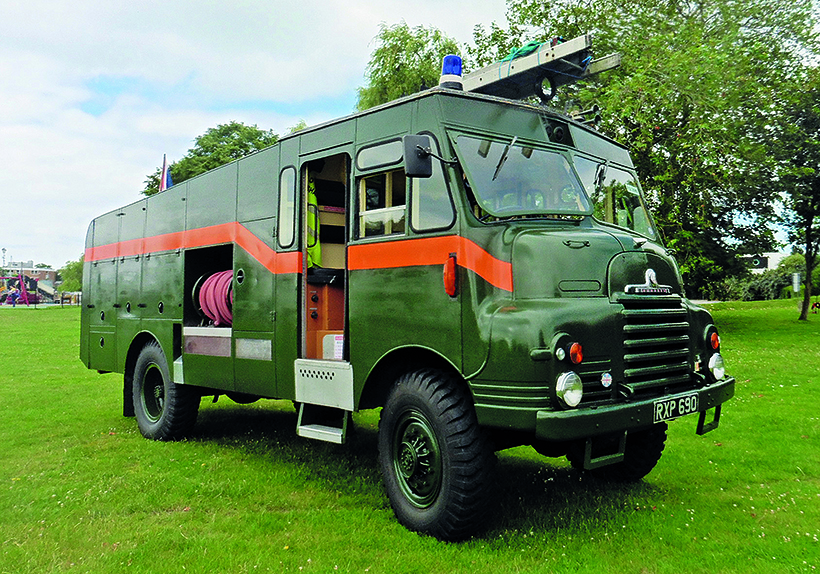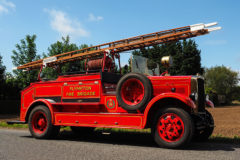Goddess for the Century
Posted by Chris Graham on 1st July 2020
Dean Reader meets a classic vehicle enthusiast who, rather than get something small and sporty, or a posh, luxury marque, gained a Goddess for the Century.

Goddess for the Century: Ashley Miller’s nicely renovated Green Goddess.
It came as a surprise to many to read on Facebook what Ashley Miller had bought mid-2018. He already had a long history of owning many classic cars and told me: “I saw the Green Goddess on eBay, advertised at Old Autos, who I’ve had a dozen-plus classic vehicles from over the past 11 or 12 years, so I was relaxed in knowing what I was buying. I part-exchanged my 1957 Daimler Conquest Century for it so, yes, I got a Goddess for the Century, and certainly have no regrets.
“My interest goes right back to having seen them in the fire brigade strikes in 1977 and 2002. I was always intrigued by them, but never thought that I’d ever ride in one, let alone own one. So it just goes to show, you really do never know exactly which direction you may head with regards classic vehicle ownership.”

Sliding doors give excellent access.
Size does matter
I’ve often seen a larger commercial – or perhaps a mini-coach – that I quite fancied, but I’m quite realistic that I have nowhere to park one, but Ashley wasn’t overly concerned: “Like any big commercial, size can be off-putting for many would-be purchasers, but it didn’t worry me. It was nothing a tape measure couldn’t sort and, yes, it fitted alongside the bungalow… just, I have to admit!”
With only 5-9mpg from its 4.9-litre, straight six engine, Ashley didn’t intend to use it too much, leaving the show duties to his Morris Minor 1000 and his MG Midget. But, whenever I see posts from him, its always the Goddess on show, and why not? There are, after all, less than 150 examples remaining, and few are truly on the road; it makes for an interesting exhibit at events, particularly Classic Cars on the Prom, which is held at the Bournemouth International Centre throughout the summer. Ashley became secretary back in 2009 and, alongside this, he runs Travel Link UK, a hire service doing airport runs and such like. And, as if that wasn’t enough, he also does wedding chauffeuring with his Minor. But all this didn’t stop Ashley finding time to renovate the Goddess.

Ample accommodation for the crew of six.
Budget restoration
Although the appliance was complete in every way, it had been unused for years but, by order of the Crown, they had to be ready to go in case of a real emergency, so the vehicle was regularly serviced and looked after; nothing mechanical was needed.
Likewise, the chassis was solid, so it’s never had any welding done and, with the panel work being aluminium over a wood framework, no metal replacement was needed, either. However, the vehicle was wearing a faded, green livery and a white stripe, so this certainly needed to be sorted out. That work started in March, 2019.

The main pumping duties are done from the rear.
During the paint-stripping stage, Ashley found some wood rot in the cab roof area, but this was easily remedied with the help of a friend. A new felt roof was also added at the same time.
He then spent weeks slowly painting the vehicle in a fresh coat of, possibly brighter, green inside and out, before adding a ‘modern’ orange stripe. Again, to do the Goddess justice, it would have cost thousands to properly restore but, looking at the photographs here, can you really tell that it’s not original?

The heart of most fire appliances – the Godiva pump.
The only addition, if I could call it that, is all the signage giving both information and warning of the dangers of climbing on the truck; many times, he’s caught people helping themselves at shows!
On permanent stand-by
With production having started in 1954, Ashley’s RHLZ was built in the last year of production, namely 1956. Based on the Bedford RL army truck, these were built for the on-going ‘Cold War’, and manned by the Auxiliary Fire Service (Civil Defence Corps) right up until 1968, when they were disbanded. If we want to split hairs, they’re not actual fire engines, but are recognised as self-propelled pumps, and were primarily on stand-by in case of a nuclear war.
The GGs could be used in a relay system over a number of miles, and discharge huge amounts of water from lakes, rivers, canals and other sources into cities hit by a nuclear attack. Although, in reality, there would probably not be much left or anyone to really operate them. They continued to remain on stand-by in case of national emergencies, like the fire-fighter strikes in 1977 and 2003-4 but, in that year, it was finally agreed by the government, that the military could take over standard fire engines, should the need arise again in the future.

Hoses of various lengths in one of the many storage compartments.
At this point, many were simply scrapped. Others were sold-off in auctions, and they went one of three ways. Into private ownership with enthusiasts, off to museums for display, or remained in use at facilities such as small airfields. Some were even exported to developing countries/states and pressed into service there. But the image of the Green Goddess is so typically British that, for many, they rank alongside the London taxi and Routemaster bus as icons of our transport history.
The Green Goddess held an impressive stock of equipment although, strangely, just a single ladder. Aside from all the hoses and reels, a selection of adaptors and nozzles giving various spray patterns were included, together with other firefighting tools. The main Sigmund pump has a capacity of 4,500 litres per minute (4,100 litres on 4×4 versions). Normal fire hoses could be used either from the main pump, which had four outlets, or from normal roadside fire hydrants, for which an assortment of connecting branches were carried.

Various attachments for hoses.
Self-contained pump
In addition, the machines carried a small Coventry Climax pump, with its own petrol engine. This delivered an additional 1,600 litres per minute, and could also draw water from a river to feed normal fire hoses, and which provided a separate and self-contained firefighting capability on a smaller scale.
A 400-gallon water tank (300 gallons on 4×4 versions like Ashley’s) was installed, which fed small-diameter hoses on each side of the vehicle, to provide immediate fire-fighting capability while the main hoses were being connected and brought into use. Going right back to basics, a small stirrup pump was carried as well; no chance of anyone resting on their laurels with a Green Goddess!

More attachments hidden away and, yes, the axe is fitted with a cover when the vehicle’s displayed at shows.
The cab was also big enough for a team of six – the charge officer, driver/pump operator and the firemen had space to move around comfortably.
At the photographic location, Ashley had to move her and, watching her being manoeuvred in a simple circle, I got the impression she was unstable. Indeed, that was a problem when these vehicles were new as Ashley explained: “Cornering is somewhat of an art, as the Goddesses built in 1954-1956 had a higher centre of gravity with the 4×4 capability added.

Opening front screens offer some airflow.
If carrying a full load of water (the tank is unbaffled), you can feel the weight swaying from side to side and forwards and backwards as the vehicle moves. In a few cases, this problem led to Green Goddesses being tipped on to their sides, while cornering too fast. What’s more, the fact that the bodies consisted of a wooden frame covered with thin aluminium panelling and a thin, wooden roof, there was no protection for the crew in the event of an accident. They may well be huge and imposing, but they are susceptible to accidents, too.”
Continuing to explain about the driving limitations, Ashley told me: “I drove lorries in the past, so I was used to large vehicles, but they were all newer than this. There’s no power steering, the gear lever is positioned to the left, rear side of the driver’s seat and it has limited synchromesh. When reversing, you’re more or less driving blind, so if you have a passenger, it’s far easier. Also, with a turning circle of 60 feet, you don’t want to get stuck anywhere small. The power is ample but slow, and a relaxing driving speed is about 45mph. The maximum I’d say is 65mph, not that I do that much thanks to that rapidly dropping fuel gauge.”

Bedford; so good they named it twice!
Hold on tight
I had to move the big old beast myself at one point. With the folding door open, I clumsily climbed over the engine cover until Ashley said it’s easier with the door shut… doh! The view was commanding to say the least and, I must admit, the gear change was not brilliant and I feared a stiff neck would follow soon after.
I only put her in first gear, handbrake off and I moved off but I just felt, well, unsafe. Perhaps I would have got used to it more with more time, but it wouldn’t have been a relaxed drive. On that note, I came away respecting yet again the job that the operators of such machinery did in the past, especially rushing to an incident.

The driver’s cab is huge and roomy.
One thing’s for sure, this Green Goddess had seen a relatively sedate life. It was stationed at Moreton-in-Marsh in 1956 for two years, before going to Steventon-Abbington in 1959. Almost 10 years later, it went to Biggin Hill, before returning to S/A in 1972. There it remained until being sold off in 2007, after which it remained unused until 2018.
Finally, Ashley wanted to thank one person in particular so, in his own words: “To my wife, who detests my vehicle collection, but allows me to enjoy my hobby. She once said to me: ‘you spend more time and money on those cars than you do on me’, to which I replied, ‘you want to know why? They don’t answer back!”
My own thanks go to Ashley Miller for taking time out of his busy schedule to enable this to happen.

The six-cylinder engine is easily accessible.

The GG only just fits at his home.

The Bedford Green Goddess is an impressive piece of kit.
For a money-saving subscription to Heritage Commercials magazine, simply click here





